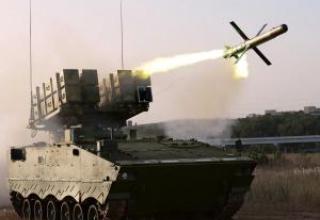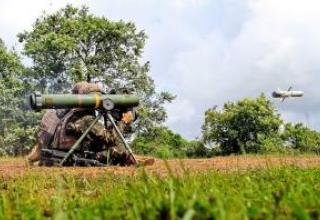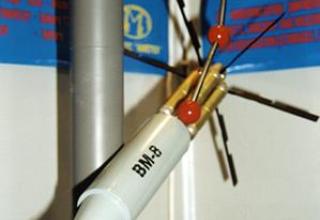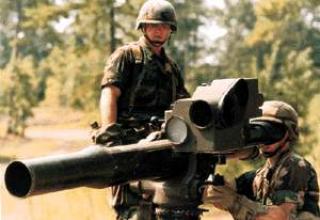
Malyutka is designed against armored targets, destroy shelters and destroy firepower and enemy points. It was developed at the Design Bureau (Kolomna) under the supervision of Chief Designer S.N. Unbeaten in 1960. The portable version of the 9K11 system, as well as the mock-up model of the 9P110 combat vehicle developed on a proactive basis, underwent extensive trials with missile launches in 1961 and it was adopted for service on 16 September 1963.
Later, the missile was upgraded, Its index is 9M14M (9K14M system). A new combat vehicle designated as 9P122 and mounted on a GAZ-41-02 vehicle was developed In 1968. The armament of the BMP-1 infantry fighting vehicle was used for the system. The BMP-1 infantry fighting vehicle was equipped with four anti-tank missiles which were manually mounted on a rail mounted above the barrel of a 73-mm smoothbore gun. Guidance was provided by 9C420 equipment. Later, the BMD-1 amphibious assault vehicle was equipped with similar weapons, but the ammunition consisted of three missiles only.
In 1969, the development of a semi-automatic version of the system under the designation 9K14P Malyutka-P was completed. The weight of the missile under the designation 9M14P was increased slightly to 11.4 kg. The 9P133 combat vehicle mounted on BRDM-2 chassis was specially developed. The new 9M14P could also be used as part of the 9K11 portable system, but only in the previous manual guidance mode. The ground equipment of the semi-automatic system proved to be more cumbersome, which excluded its use in the man-portable system.
In addition to its use in portable and self-propelled systems, in the first half of the 1960s work was carried out to equip the Malyutka complexes with PT-76, T-62 and T-10m tanks, but this equipment was not adopted for service.
The serial T-10M tank had a 122 mm M-62 rifled gun with an initial armour-piercing projectile velocity of 950 m/s and a firing efficiency of about 70% for 1.5-2 km. In order to increase the range of fire the said tank was equipped with the Malyutka guided missiles (infantry version). The launcher for three Malyutka rockets was located at the rear of the tank turret. The installation of guided missiles on the tank allowed for the firing of three rounds at a range of 2.5-3 km and ensured armour permeability at an angle of 60º of about 200 mm.
Already in 1963, work was done to place six "Malyutok" on the Mi-1U helicopter. In 1974, was created and later produced for export helicopter Mi-8TBK, different from the Mi-8TV using six "Malyutok" instead of four "Falang". Production of Mi-2 helicopters was transferred to Poland, where a number of modifications of the Mi-2 was developed, including the Mi-2URP, created in 1979, armed with four "Malyutokami".
Malyutka system can be attributed to the undoubted success of domestic rocket industry. In addition to "service" in the Soviet Army for several decades, it was exported to dozens of foreign countries and repeatedly used in local conflicts, during which it confirmed its high combat efficiency and reliability in operation. During the production period, more than 300,000 PTWCs of this type have been delivered to the domestic armed forces and abroad (to more than 35 countries).
The missile system itself has been produced in Bulgaria, Iran, Yugoslavia and China. Malyutka type system were produced till 1984 in the USSR. At present, the Heavy Machine Building Design Bureau offers a variant of modernization of the system, which is known under the designation Malyutka-2.
In the West the system and its modifications are known under the designation AT-3 Sagger.
Composition:
The 9M14 missile consists of a 9N110 missile docked before launching and a wing compartment. They are connected very quickly, using special locks. In the wing compartment on the axis of the series are located - the marching engine, steering machine and gyro. In the ring space around the marshal engine there is a combustion chamber of the starting engine with a multipole charge, and behind it there is a coil of wire communication line. On the outer surface of the rocket body there is a tracker.
The 9M14 missile is equipped with a single-channel control system. Only one steering machine is installed on the missile, moving the nozzles (deflectors) on two opposing diagonally directed nozzles of the marching engine. In this case, alternately controlled by the pitch and course, as the rocket in flight rotates relative to the longitudinal axis with a constant angular velocity - 8.5 rpm per second. The initial roll turns are given when the starting engine is running with the corresponding orientations of the nozzle axes. The rotation is then maintained by setting the wing plane at an angle to the longitudinal axis of the missile. A three-stage gyroscope with mechanical unwinding is used to link the angular position of the missile to the ground coordinate system during the launch by means of a belt. The rocket has no onboard power sources, and the only steering machine operates from the current supplied by ground equipment on one of the three-stage water-resistant wire circuits.
The wings of the rocket in the transport position are folded towards each other, so that the transverse dimensions do not exceed 185x185mm with a wingspan of 393mm.
For the portable complex 9K11 carrying missile with a launch guide is carried in a shoulder suitcase-range 9P111. In combat position, the case of the shoulder-ring serves as the basis for the launcher. Two soldiers of the anti-tank calculation carry a pack ¹2 and ¹3 - a carrying case with missiles weighing 18.1 kg and launchers, and the commander of the calculation, he is the same senior operator (gunner), carries a pack ¹1 - control panel 9C415 with a monocular vision 9Sh16 and guidance equipment, weighing 12.4 kg. Optical vizier has eightfold zoom, only day mode, field of view 22.5 °.
The developers of the complex paid great attention to reducing the labor intensity of the rocket and reducing its cost. In the body of the combat unit and wing compartment widely used plastics, fiberglass was made of a suitcase end for carrying the missile.
The upgraded version of the 9M14M missile was equipped with a more advanced combat unit, the contacts of the fuse were transferred from the combat unit to the engine, and an additional rope rope was introduced. The 9M14M guided missile is designed to fight moving and stationary armored targets and firing points at ranges from 500 to 3000 m.
The control system enables the target to be hit from one or two shots by a trained operator.
The projectile is controlled and pointed at the target by commands transmitted to the projectile via wires from the control panel, while observing the projectile and the target in the optical viewer.
The combat unit 9H110M of the guided missile 9M14M with an explosive device is placed in the head of the projectile. A cumulative charge with a copper funnel is placed in the warhead. The casing of the combat unit is plastic.
The propulsion system is a two-chamber jet engine equipped with two 9X110 powder charges - starting and marching.
During combustion, the starting charge informs the projectile specified flight speed and after leaving the launcher guide, the rotational motion.
The marching charge provides maintenance of the projectile's flight speed on the whole trajectory.
The wing compartment consists of a plastic body and four wings connected to the body by axles. The wings are made folding and are held in open position by stops. When transporting a projectile in the capping the wings are folded.
Trasier 9X44 is used to provide visual observation of the projectile when pointing it at the target. The trasser is fixed on the wing compartment body and ignited simultaneously with the starting charge.
In the starting section, the projectile is spun at an angular speed of 8.5 r/s by tilting the starting engine nozzles.
In the marching area, the rotation of the projectile is supported by wings mounted at an angle of 3°15' to the longitudinal axis of the projectile, and a microcable of a wire line of communication running from the reel.
The projectiles of the first series releases have the index 9M14. 9M14M differs from 9M14 in that it has a fifth bungee on one of the starting nozzles, which is an additional support on the guide, and knife contacts of the fuse electrical circuit connector are located on the starting chamber housing (knife contacts of 9M14 are located on the combat unit housing). The combat unit of 9M14 projectiles is 9H110. 9H110 combat units are not interchangeable with 9H110M combat units and are equipped only with 9M14 rounds.
The highest armour penetration rate of 520 mm was achieved in the modification of 9M14P1 (see description of 9M14P/9M14P1).
The disadvantages of the complex should be attributed to:
- manual control (except 9M14P) and, consequently, the dependence of the complex efficiency on the degree of training and psychophysical state of the operator.
- insufficiently high level of combat readiness - for all the achieved convenience of operation before combat use, the missile requires taking out of the backpack suitcase, docking the combat unit, opening the wing consoles, placing the missile on the launcher guide, which, in turn, also needs to be deployed when moving from a camping position to a combat one.
- To ensure the operator's safety from the gas stream of the rocket engine, the control panel is located away from the launcher. It also takes time to bring the launch vehicle to the line of sight at the side of the missile. This largely determines the minimum launch range limitation (see kill zone diagram).
- The insufficient flight speed allows the enemy to take effective countermeasures.
Characteristics:
| 9K11 complex | |
| Range of fire, m | 500 - 3000 |
| Number of missiles in the complex | 2 |
| The military calculation, man. | 3 |
| Battle point time, sec. | 100 |
| Rate of fire, line of fire/min. | 2 |
| 9M14M rocket | |
| The dimensions of the rocket, mm | |
| - housing diameter | 125 |
| - length | 860 |
| - plumage scale | 393 |
| - transverse dimensions of the projectile with folding wings | 185×185 |
| Control System | manual with the line of communication on wires, the method of pointing - on 3 points |
| Average rocket speed, m/s | 115 |
| Average marching speed, m/s | 120 |
| Time of flight to maximum range, sec. | 26 |
| Speed of rotation of the projectile in flight, r. / min | 8.5 |
| Probability of hitting a target like a tank | 0.7 |
| Weight, kg. | 10,9 |
| Fighting unit | cumulative |
| Weight of combat unit, kg | 2.6 |
| Armor-piermeable, mm: - at an angle of 0° - at an angle of 60° |
400 200 |
| Closure dimensions 9Y618 (with one shell), mm: | |
| - length | 1051 |
| - width | 340 |
| - altitude | 350 |
| Minimal range of sighting, m | 500 |
| Maximum range of controlled flight, m | 3000 |
| 9M14P Missile | |
| The dimensions of the rocket, mm: - caliber (body diameter) - length - wingspan (unfolded) |
125 860 393 |
| Average rocket speed, m/s | 115 |
| Time of flight to maximum range, sec. | 26 |
| Mass of the rocket, kg. | 11.4 |
| Fighting unit | cumulative |
| Armor-piermeable, mm | 520 |
| Probability of hitting a target like a tank | 0.9 |
Testing:
MTUR "Malyutka" was very successfully used during the Arab-Israeli War in 1973, it was with its help that almost the entire Israeli tank fleet was destroyed - about 800 vehicles. Only on October 6, 1973, for example, the 252nd Israeli Tank Division was defeated - more than a hundred vehicles were hit.
Sources:
- Ангельский Р.Д. "Отечественные противотанковые комплексы" - М: ООО "Издательство Астрель", 2002,-192с.
- Изделие 9П122. Техническое описание 9П122 ТО. Министерство оборонной промышленности СССР, 1971. - С. 5-9.
- Управляемый снаряд 9М14М (9М14). Техническое описание. - М.: Воениздат, 1966. - С.4-6.
- Russian Missile Systems - www.wonderland.org.nz
- "Czas Wiatrakow"
- Управляемый снаряд 9М14П. Техническое описание. Военное издательство МО СССР, 1972г.
- Изделие 9С446. Техническое описание. Часть I. БЛ1.335.005 ТО/. - М.: Воениздат, 1980. - 120 С. (для изделия 9П133 и снарядов 9М14П1 (9М14П), 9М14). (Смотрите электронный вариант издания).
- Дело 51. Сводные данные и материалы по уровню реактивного вооружения. Начато 25.07.1962 г. Окончено 04.11.1962 г. / АННОТАЦИЯ по танку T-I0М с управляемыми реактивными снарядами "Малютка". 26.09.1962 г. Документ без подписей и мест для них // РГАЭ. Ф. 298. Оп. 1. Д. 3058. Л. 55,55об.










